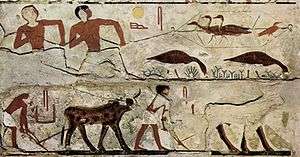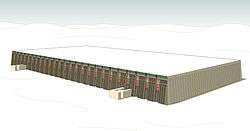Nefermaat
Nefermaat I was an Ancient Egyptian prince, a son of king Sneferu. He was a vizier possessing the titles of the king's eldest son,[2] royal seal bearer, and prophet of Bastet. His name means "Maat is beautiful" or "With perfect justice".
Nefermaat I | |
|---|---|
 Painting from Nefermaat's tomb at Meidum | |
| Resting place | mastaba 16, Meidum |
| Occupation | vizier royal seal bearer prophet of Bastet |
| Spouse(s) | Itet |
| Children | Vizier Hemiunu; several others |
| Parent(s) | Sneferu and unknown wife |
Biography
Nefermaat was the eldest son of Sneferu, the king and founder of the Fourth Dynasty of Egypt and his first wife. He was a half-brother of Khufu. Nefermaat's wife was Itet, also spelled as Atet. Fifteen of Nefermaat's offspring are named in his tomb, sons Hemiunu, Isu, Teta, Khentimeresh and daughters Djefatsen and Isesu are depicted as adults, while sons Itisen, Inkaef, Serfka, Wehemka, Shepseska, Kakhent, Ankhersheretef, Ankherfenedjef, Buneb, Shepsesneb and Nebkhenet and daughter Pageti are shown as children. His son Hemiunu is probably identical with vizier Hemiunu who was believed to have helped plan the Great Pyramids.
One of Nefermaat's sisters, Nefertkau had a son also called Nefermaat.[3]
Tomb

Nefermaat was buried in mastaba 16 at Meidum. Nefermaat was one of several relatives of Pharaoh Sneferu who was buried in Meidum. The tomb is known for the special technique used for drawing the scenes. Sculptors carved deeply incised images that then were filled with colored paste. This method was labor-intensive because the paste tended to dry, crack, and then fall out.[4] The technique results in vividly colored scenes. This tomb is the only one known to date showing this technique. The fact that later, the plaster cracked and resulted in the loss of the paste, likely led to craftsmen abandoning this type of decoration.[5]
Nefermaat's tomb is famous for the scene referred to as the "Meidum Geese" (now in the Egyptian Museum, JE 34571/ CG 1742). Discovered in 1871 by Auguste Mariette and Luigi Vassalli, the scene was executed in painted plaster. The painting was removed from the wall in order to be reassembled inside the Bulaq Museum. The full scene depicts six geese (greylag, greater white-fronted and red-breasted geese); three pointing to the left and three pointing to the right. Each group of three geese consists of one goose shown with head bowed down, eating, and two geese with heads held up. Each group of three animals represents many geese, as three represents the plural in Egyptian imagery. There are differences in the plumage of the birds that breaks the overall symmetry of the scene. This example of Egyptian painting is considered a masterpiece.[5][6]A 2015 research paper by Francesco Tiradritti at the Kore University of Enna, published on LiveScience, suggested that the painting could be a nineteenth-century forgery, possibly made by Vassalli.[7][6] Tiradritti's claims were promptly dismissed by Zahi Hawass and other Egyptian authorities.[6][8]
 The full scene
The full scene Left section with a greylag and two white-fronted geese
Left section with a greylag and two white-fronted geese Right section with a greylag and two red-breasted geese
Right section with a greylag and two red-breasted geese Detail of red-breasted geese
Detail of red-breasted geese
| Wikimedia Commons has media related to Nefermaat. |
References
- Hermann Ranke: Die ägyptischen Personennamen. Verlag von J. J. Augustin in Glückstadt, 1935., p. 196
- Nefermaat page from digitalegypt (University College London)
- Dodson, Aidan and Hilton, Dyan. The Complete Royal Families of Ancient Egypt. Thames & Hudson. 2004. ISBN 0-500-05128-3, pp.52-53, 56-61
- The Egyptian Museum in Cairo: a walk through the alleys of ancient Egypt, by Farid Atiya, Abeer El-Shahawy, Farid S. Atiya, page 71
- Tiradritti,F. (editor), Egyptian Treasures from the Egyptian Museum in Cairo. Harry N. Abrams Inc. 1999, pp. 60-61, ISBN 0-8109-3276-8
- El-Aref, Nevine (April 9, 2015). "Controversy over the Meidum Geese". Al-Ahram Weekly. Cairo. Archived from the original on February 18, 2018. Retrieved September 28, 2015.
- Owen, Jarus (March 31, 2015). "Shocking Discovery: Egypt's 'Mona Lisa' May Be a Fake". LiveScience. Retrieved September 28, 2015.
- Hawass, Zahi (April 9, 2015). "The Meidum Geese Are Not A Fake". Dr. Zahi: The Man with the Hat. Retrieved 15 July 2018.